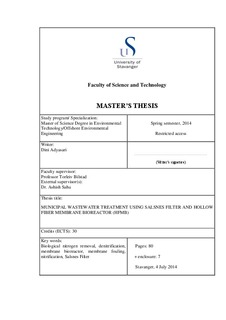| dc.description.abstract | This study investigated the performance of Salsnes Filter (SF) as a primary treatment prior to hollow fiber membrane bioreactor (HFMB) for nitrogen removal. The objective was to determine whether influent particle size removed during primary treatment had any detrimental effect on downstream biological processes, especially nitrogen removal. The pilot scale testing was conducted at Nordre Follo Wastewater Treatment Plant, Oslo region, Norway.
This pilot system comprised of two anoxic tanks and one aerobic tank with hollow fiber membrane. Hollow fiber module type ZW-10 was provided by GE Water Technologies. One system was fed with influent wastewater that has been filtered with SF 2 mm and represents the degritted wastewater (treatment Train C), while the other system was filtered specifically with SF 33 μm (treatment Train D). Two boundary conditions were used, the first investigated SF and MBR as the whole system, and the last reviewed the effect of different particle size on the performance of MBR system.
For both boundary conditions, it was found that both treatment trains have similar capability in reducing Total Suspended Solids (TSS), Total Chemical Oxygen Demand (TCOD), Total Biochemical Oxygen Demand (TBOD5), and Total Phosphorus (TP) with average removal percentage of 99 %, 92 %, 99 %, and 79 % respectively, which met the discharge requirement criteria. However, Total Nitrogen (TN) effluent results showed that treatment Train C has better average removal efficiency of 73 % compared to treatment Train D’s 68 % due to higher TCOD/TN ratio after SF treatment. Low TCOD/TN ratio in treatment Train D hampered the denitrification process, as confirmed by lower denitrification rate and higher NO3-N concentration in the permeate than its counterpart. Nitrification and denitrification were proven to be the main factor of biological nitrogen removal compared to cell assimilation process.
The HFMB operated smoothly during the experiment, with no excessive fouling detected. Membrane in treatment Train C experienced more frequent rapid transmembrane pressure (TMP) peaks due to abundance of organic and organic matters, making it more vulnerable of membrane fouling for long term operation.
Overall, both systems produced high quality effluent and free of TSS, even though treatment Train C was susceptible of membrane fouling and treatment Train D had slight problem in its nitrogen removal process. Further economic observation should be implemented to decide which system is more cost effective between the requirement of more frequent membrane maintenance cleaning for treatment Train C or external carbon source addition for treatment Train D. | nb_NO |
